Solvent- and Catalyst-Free Synthesis of gem-Difluorinated and Polyfluoroarylated Compounds with Nucleophilic or Electrophilic Fluorine-Containing Reaction Partners, Respectively
Abstract
1. Introduction
2. Results and Discussion
3. Materials and Methods
3.1. Materials
3.2. General Procedure for the Synthesis of gem-Difluorinated 2-Hydroxy-1,4-dicarbonyl Products
3.3. General Procedure for the Synthesis of Polyfluoroarylated Compounds
4. Conclusions
Supplementary Materials
Author Contributions
Funding
Institutional Review Board Statement
Informed Consent Statement
Data Availability Statement
Acknowledgments
Conflicts of Interest
References
- Sarkar, A.; Santra, S.; Kundu, S.K.; Hajra, A.; Zyryanov, G.V.; Chupakhin, O.N.; Charushin, V.N.; Majee, A. A decade update on solvent and catalyst-free neat organic reactions: A step forward towards sustainability. Green Chem. 2016, 18, 4475–4525. [Google Scholar] [CrossRef]
- Cao, Z.; Zhu, Q.; Lin, Y.W.; He, W.M. The concept of dual roles design in clean organic preparation. Chin. Chem. Lett. 2019, 30, 2132–2138. [Google Scholar] [CrossRef]
- Baruah, B.; Deb, M.L. Catalyst-free and additive-free reactions enabling C−C bond formation: A journey towards a sustainablefuture. Org. Biomol. Chem. 2021, 19, 1191–1229. [Google Scholar] [CrossRef]
- Lu, B.; Xie, Z.; Lu, J.; Liu, J.; Cui, S.; Ma, Y.; Hu, X.; Liu, Y.; Zhong, K. Highly atom-economic, catalyst-free, and solvent-free synthesis of phthalazinones. ACS Sustain. Chem. Eng. 2019, 7, 134–138. [Google Scholar] [CrossRef]
- Liao, T.M.; Ma, W.J.; Gao, Y.N.; Bian, M.; Jiang, M.; Liu, J.T.; Chen, H.Y.; Liu, Z.J. Facile synthesis of (polyfluoro)alkanesulfinyl 4-isoxazolines: A stepwise solvent- and catalyst-free approach or a one-pot process in water. Green Chem. 2023, 25, 5233–5239. [Google Scholar] [CrossRef]
- Li, M.Y.; Li, J.T.; Gu, A.; Nong, X.M.; Zhai, S.Y.; Yue, Z.Y.; Feng, C.G.; Liu, Y.B.; Lin, G.Q. Solvent-free and catalyst-free direct alkylation of alkenes. Green Chem. 2023, 25, 7073–7078. [Google Scholar] [CrossRef]
- Gillis, E.P.; Eastman, K.J.; Hill, M.D.; Donnelly, D.J.; Meanwell, N.A. Applications of fluorine in medicinal chemistry. J. Med. Chem. 2015, 58, 8315–8359. [Google Scholar] [CrossRef] [PubMed]
- Ni, C.; Hu, J. The unique fluorine effects in organic reactions: Recent facts and insights into fluoroalkylations. Chem. Soc. Rev. 2016, 45, 5441–5454. [Google Scholar] [CrossRef] [PubMed]
- Belhomme, M.-C.; Besset, T.; Poisson, T.; Pannecoucke, X. Recent progress toward the introduction of functionalized difluoromethylated building blocks onto C(sp2) and C(sp) centers. Chem.-Eur. J. 2015, 21, 12836–12865. [Google Scholar] [CrossRef] [PubMed]
- Feng, Z.; Xiao, Y.-L.; Zhang, X. Transition-metal (Cu, Pd, Ni)-catalyzed difluoroalkylation via cross-coupling with difluoroalkyl halides. Acc. Chem. Res. 2018, 51, 2264–2278. [Google Scholar] [CrossRef] [PubMed]
- Xiao, H.; Zhang, Z.; Fang, Y.; Zhu, L.; Li, C. Radical Trifluoromethylation. Chem. Soc. Rev. 2021, 50, 6308–6319. [Google Scholar] [CrossRef]
- Pattison, G. Methods for the synthesis of α,α-difluoroketones. Eur. J. Org. Chem. 2018, 2018, 3520–3540. [Google Scholar] [CrossRef]
- Liu, C.; Zhang, B. Facile access to fluoroaromatic molecules by transition-metal-free C–F bond cleavage of polyfluoroarenes: An efficient, green, and sustainable protocol. Chem. Rec. 2016, 16, 667–687. [Google Scholar] [CrossRef] [PubMed]
- Yuan, Y.; Zhang, M.; Tang, X.; Piper, J.L.; Peng, Z.H.; Ma, J.A.; Wu, J.; Zhang, F.G. Photoinduced defluorinative branch-selective olefination of multifluoro (hetero)arenes. Org. Lett. 2023, 25, 883–888. [Google Scholar] [CrossRef]
- Moseev, T.D.; Varaksin, M.V.; Gorlov, D.A.; Charushin, V.N.; Chupakhin, O.N. Recent advances in the functionalization of polyfluoro(aza)aromatics via C-C coupling strategies. Org. Biomol. Chem. 2021, 19, 4429–4459. [Google Scholar] [CrossRef] [PubMed]
- Decostanzi, M.; Campagne, J.M.; Leclerc, E. Fluorinated enol ethers: Their synthesis and reactivity. Org. Biomol. Chem. 2015, 13, 7351–7380. [Google Scholar] [CrossRef] [PubMed]
- Hu, X.S.; Yu, J.S.; Zhou, J. Catalytic selective mono- and difluoroalkylation using fluorinated silyl enol ethers. Chem. Commun. 2019, 55, 13638–13648. [Google Scholar] [CrossRef]
- Du, G.F.; Xing, F.; Gu, C.Z.; Dai, B.; He, L. N-heterocyclic carbenecatalysed pentafluorophenylation of aldehydes. RSC Adv. 2015, 5, 35513–35517. [Google Scholar] [CrossRef]
- Liu, Z.Q.; Kole, G.K.; Budiman, Y.P.; Tian, Y.M.; Friedrich, A.; Luo, X.L.; Westcott, S.A.; Radius, U.; Marder, T.B. Transition metal catalyst-free, base-promoted 1,2-additions of polyfluorophenylboronates to aldehydes and ketones. Angew. Chem. Int. Ed. 2021, 60, 16529–16538. [Google Scholar] [CrossRef]
- Li, J.; Xi, W.; Zhong, R.; Yang, J.; Wang, L.; Ding, H.; Wang, Z. HFIP-catalyzed direct dehydroxydifluoroalkylation of benzylic and allylic alcohols with difluoroenoxysilanes. Chem. Commun. 2021, 57, 1050–1053. [Google Scholar] [CrossRef]
- Wu, H.; Hong, P.; Xi, W.; Li, J. Divergent synthesis of gem-difluorinated oxa-spirocyclohexadienones by one-pot sequential reactions of p-hydroxybenzyl alcohols with difluoroenoxysilanes. Org. Lett. 2022, 24, 2488–2493. [Google Scholar] [CrossRef] [PubMed]
- Zhao, J.; Liu, L.; Zhang, H.; Wu, Y.; Wang, D.; Chen, Y. Rapid and convenient synthesis of aryl- and heteroaryl-α-hydroxy-α-trifluoromethyl acetate via Friedel–Crafts alkylation under solvent- and catalyst-free conditions. Tetrahedron Lett. 2006, 47, 2511–2514. [Google Scholar] [CrossRef]
- Stavber, G.; Stavber, M.; Stavber, S. Solvent-free fluorination of organic compounds using N–F reagents. Tetrahedron Lett. 2007, 48, 2671–2673. [Google Scholar] [CrossRef]
- Yang, X.; Chen, Z.; Cai, Y.; Huang, Y.; Shibata, N. An aza-Michael addition protocol to fluoroalkylated β-amino acid derivatives and enantiopure trifluoromethylated N-heterocycles. Green Chem. 2014, 16, 4530–4534. [Google Scholar] [CrossRef]
- Matador, E.; Monge, D.; Fernández, R.; Lassaletta, J.M. Solvent-free synthesis of quaternary α-hydroxy α-trifluoromethyl diazenes: The key step of a nucleophilic formylation strategy. Green Chem. 2016, 18, 4042–4050. [Google Scholar] [CrossRef]
- Yang, J.; Liu, S.; Hong, P.; Li, J.; Wang, Z.; Ren, J. Synthesis of 2,2-difluoro-3-hydroxy-1,4-diketones via an HFIP-catalyzed Mukaiyama Aldol reaction of glyoxal monohydrates with difluoroenoxysilanes. J. Org. Chem. 2022, 87, 1144–1153. [Google Scholar] [CrossRef] [PubMed]
- Yu, J.S.; Liu, Y.L.; Tang, J.; Wang, X.; Zhou, J. Highly efficient “on water” catalyst-free nucleophilic addition reactions using difluoroenoxysilanes: Dramatic fluorine effects. Angew. Chem. Int. Ed. 2014, 53, 9512–9516. [Google Scholar] [CrossRef]
- Wang, P.; Tao, W.J.; Sun, X.L.; Liao, S.; Tang, Y. A highly efficient and enantioselective intramolecular Cannizzaro reaction under TOX/Cu(II) catalysis. J. Am. Chem. Soc. 2013, 135, 16849–16852. [Google Scholar] [CrossRef]
- Rong, M.Y.; Li, J.S.; Zhou, Y.; Zhang, F.G.; Ma, J.A. Catalytic enantioselective synthesis of difluoromethylated tetrasubstituted stereocenters in isoindolones enabled by a multiple-fluorine system. Org. Lett. 2020, 22, 9010–9015. [Google Scholar] [CrossRef]
- Zhao, P.; Zhou, Y.; Yu, X.X.; Huang, C.; Wu, Y.D.; Yin, G.D.; Wu, A.X. Iodine-Promoted Multicomponent Synthesis of 2,4-Diamino-1,3,5-triazines. Org. Lett. 2020, 22, 8528–8532. [Google Scholar] [CrossRef]
- Hao, Y.J.; Yu, J.S.; Zhou, Y.; Wang, X.; Zhou, J. Influence of C−F···H−X interactions on organic reactions. Acta Chim. Sin. 2018, 76, 925–939. [Google Scholar] [CrossRef]
- Zhang, Q.X.; Li, Y.; Wang, J.; Yang, C.; Liu, C.J.; Li, X.; Cheng, J.P. B(C6F5)3/Chiral Phosphoric Acid Catalyzed Ketimine–Ene Reaction of 2-Aryl-3H-indol-3-ones and α-Methylstyrenes. Angew. Chem. Int. Ed. 2020, 59, 4550–4556. [Google Scholar] [CrossRef] [PubMed]
- Singh, P.; Panda, G. Linearization of carbohydrate derived polycyclic frameworks. RSC Adv. 2014, 4, 31892. [Google Scholar] [CrossRef]
- Jagt, D.L.V.; Han, L.-P.B.; Lehman, C.H. Effects of substituents on the rates of disproportionation of substituted phenylglyoxals in alkaline. J. Org. Chem. 1972, 37, 4100. [Google Scholar] [CrossRef][Green Version]
- Tafelska-Kaczmarek, A.; Prewysz-Kwinto, A.; Skowerski, K.; Pietrasiak, K.; Kozakiewicz, A.; Zaidlewicz, M. Asymmetric synthesis of β-amino alcohols by the transfer hydrogenation of α-keto imines, Tetrahedron. Asymmetry 2010, 21, 2244. [Google Scholar] [CrossRef]
- Amii, H.; Kobayashi, T.; Hatamoto, Y.; Uneyama, K. Mg0-promoted selective C–F bond cleavage of trifluoromethyl ketones: A convenient method for the synthesis of 2,2-difluoro enol silanes. Chem. Commun. 1999, 1323–1324. [Google Scholar] [CrossRef]
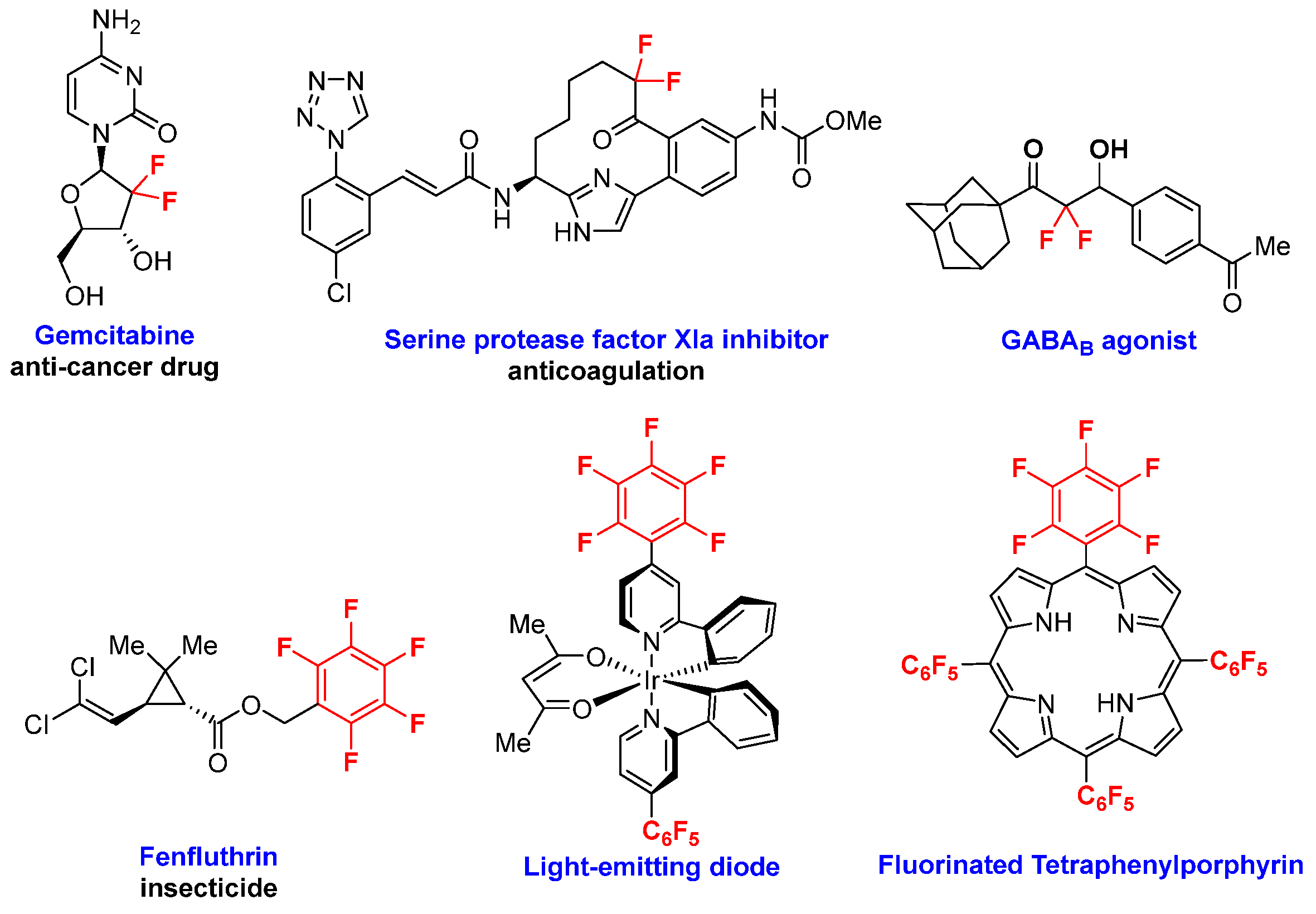
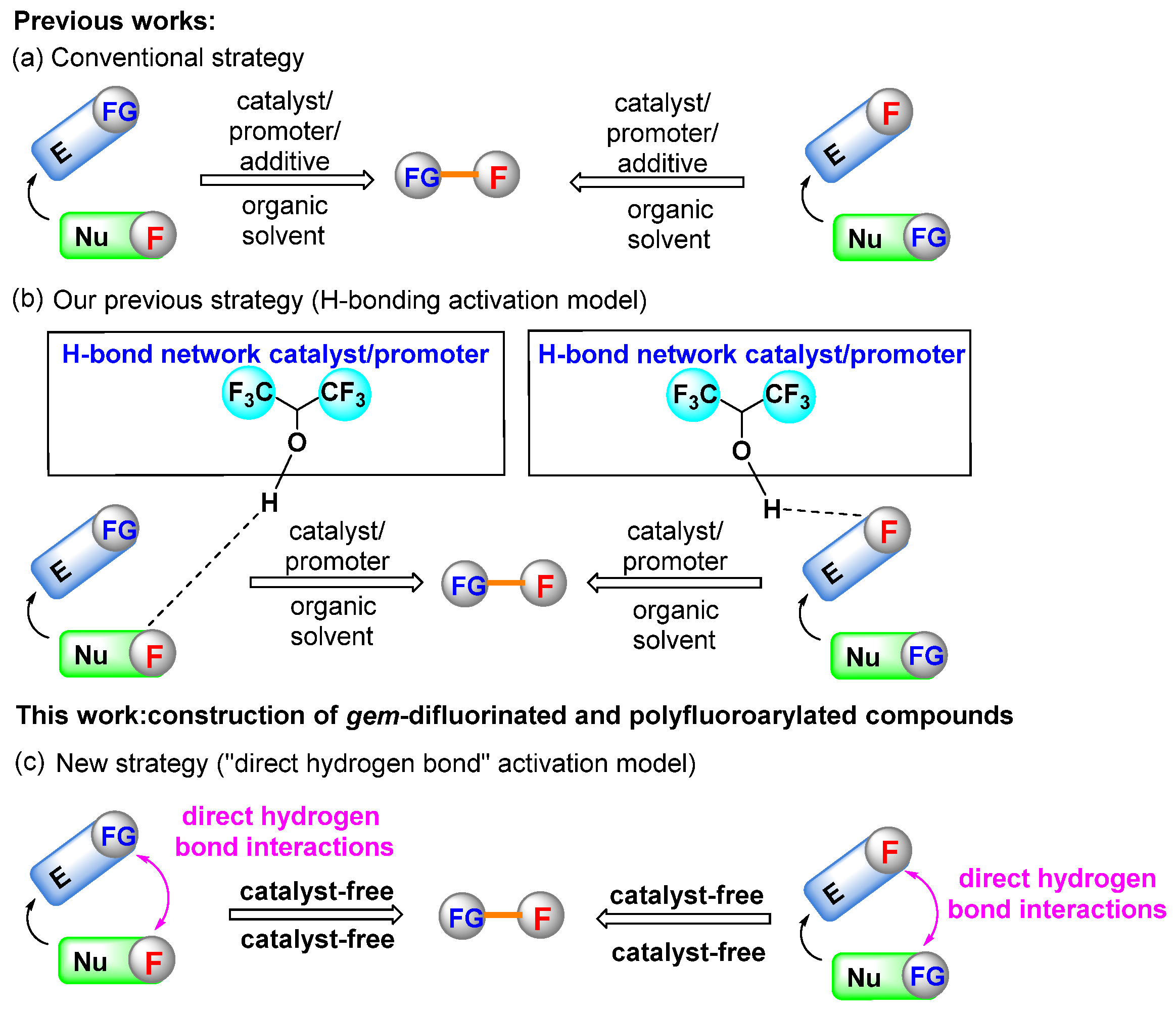
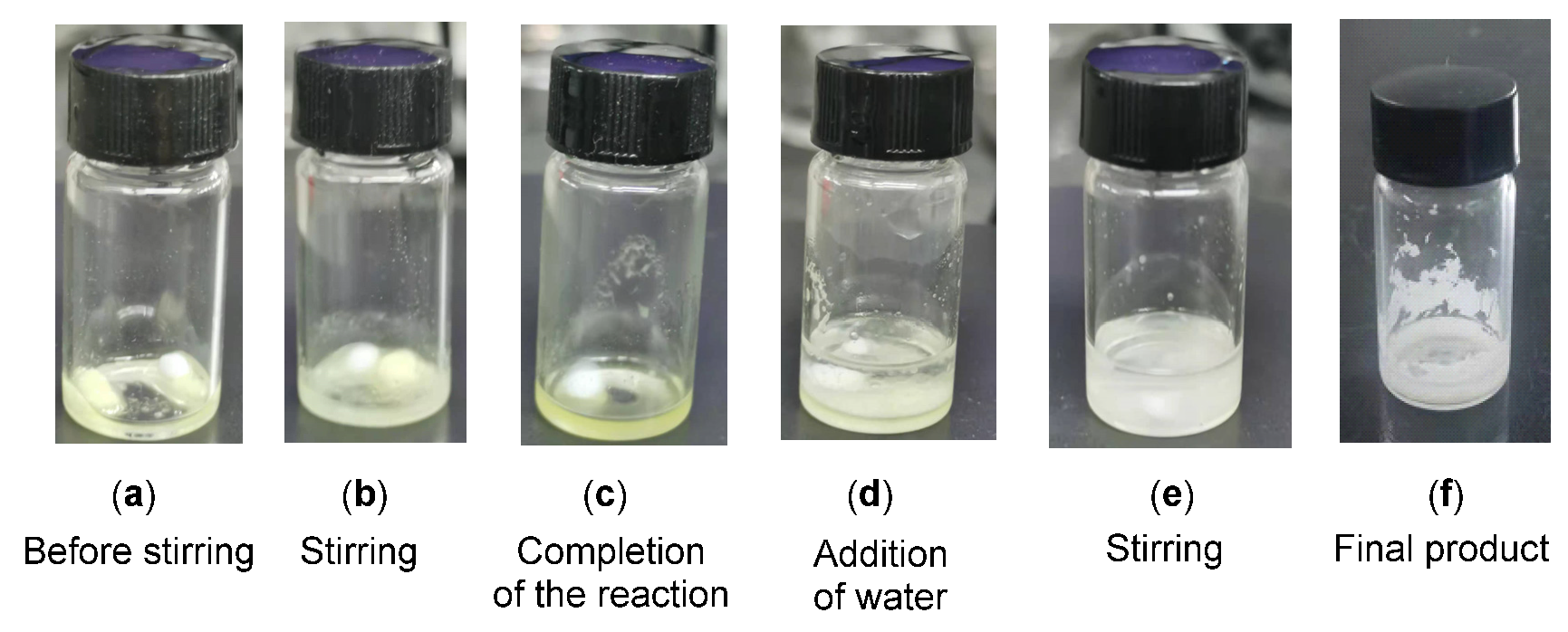
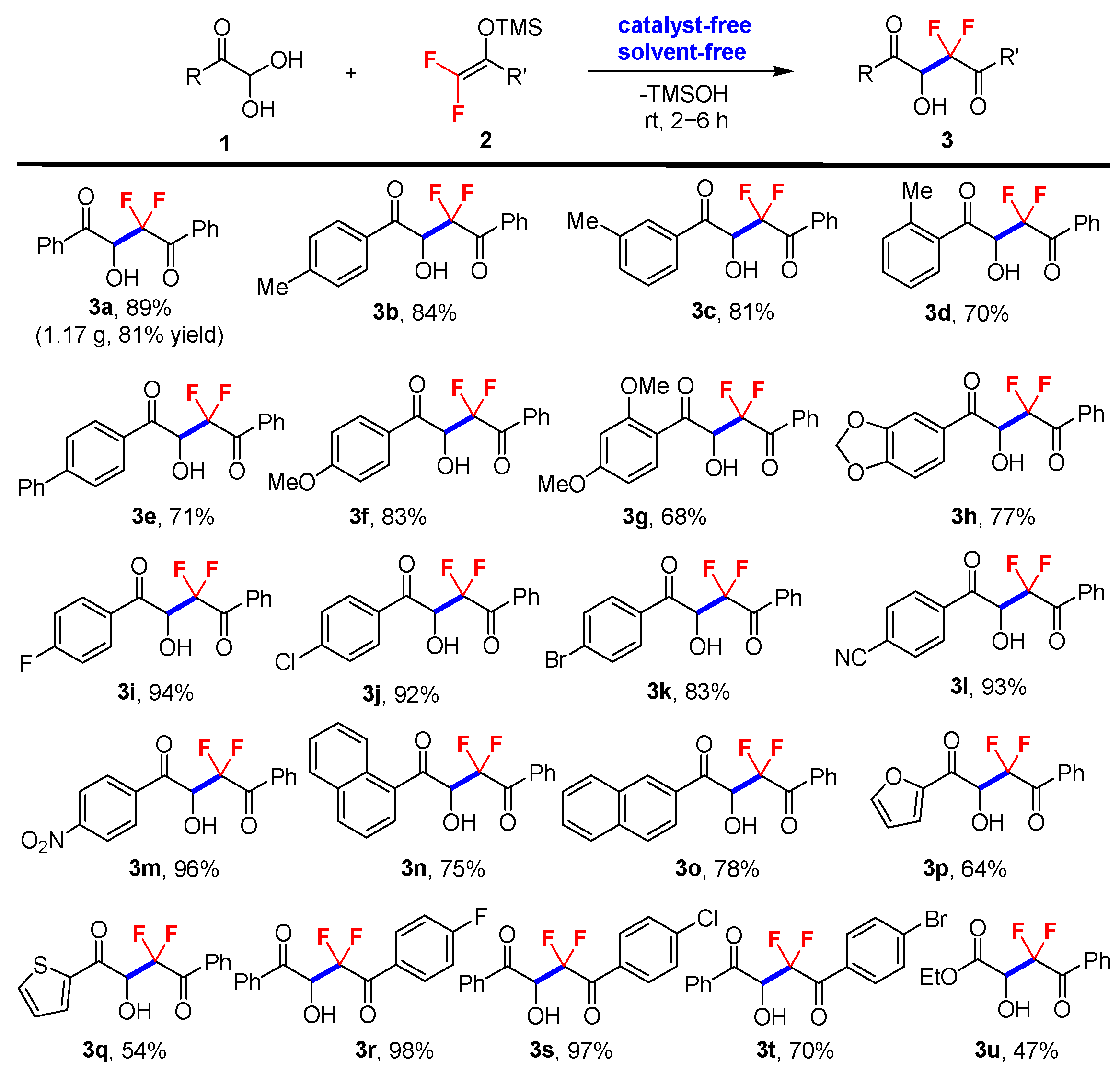
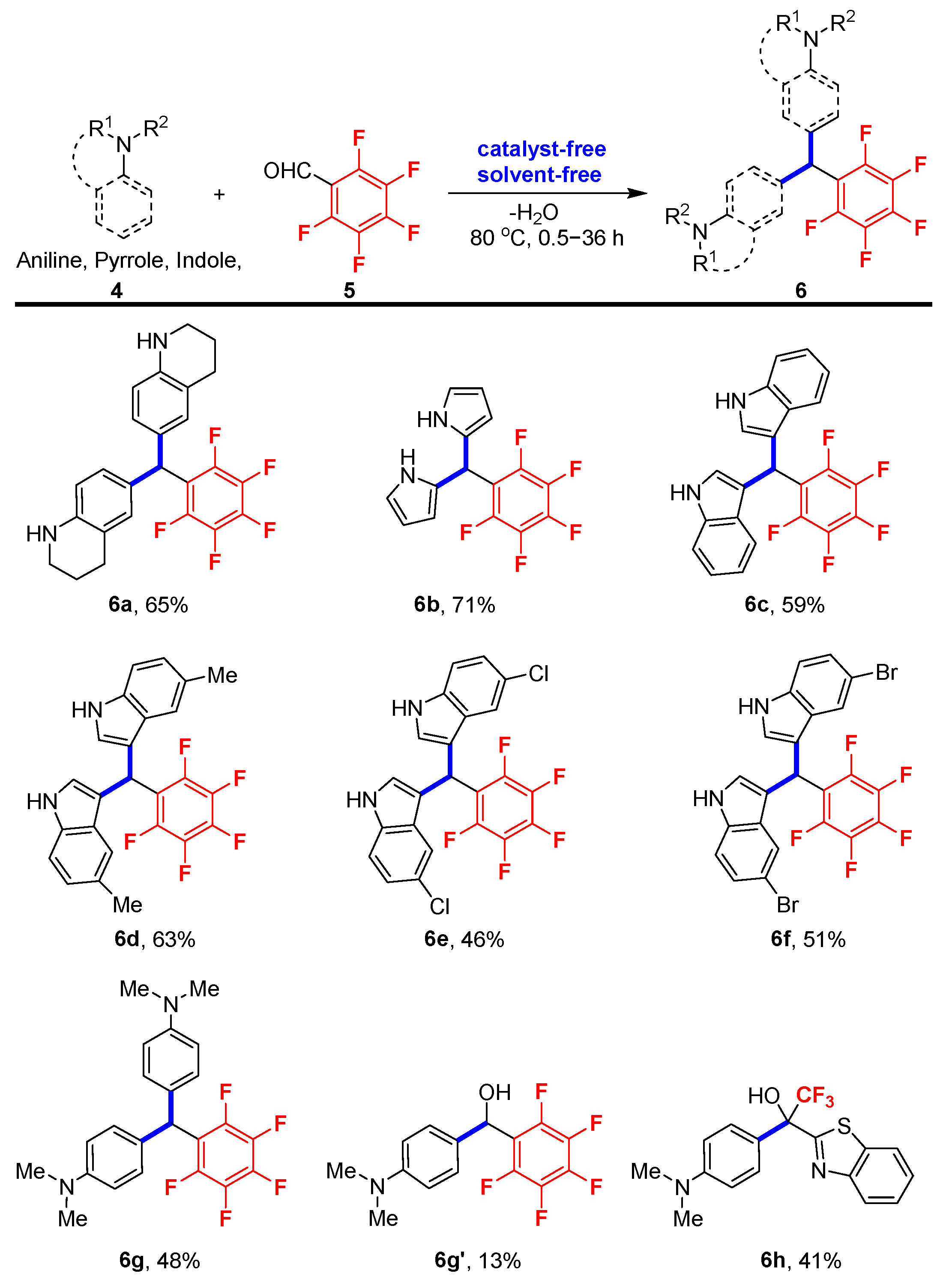
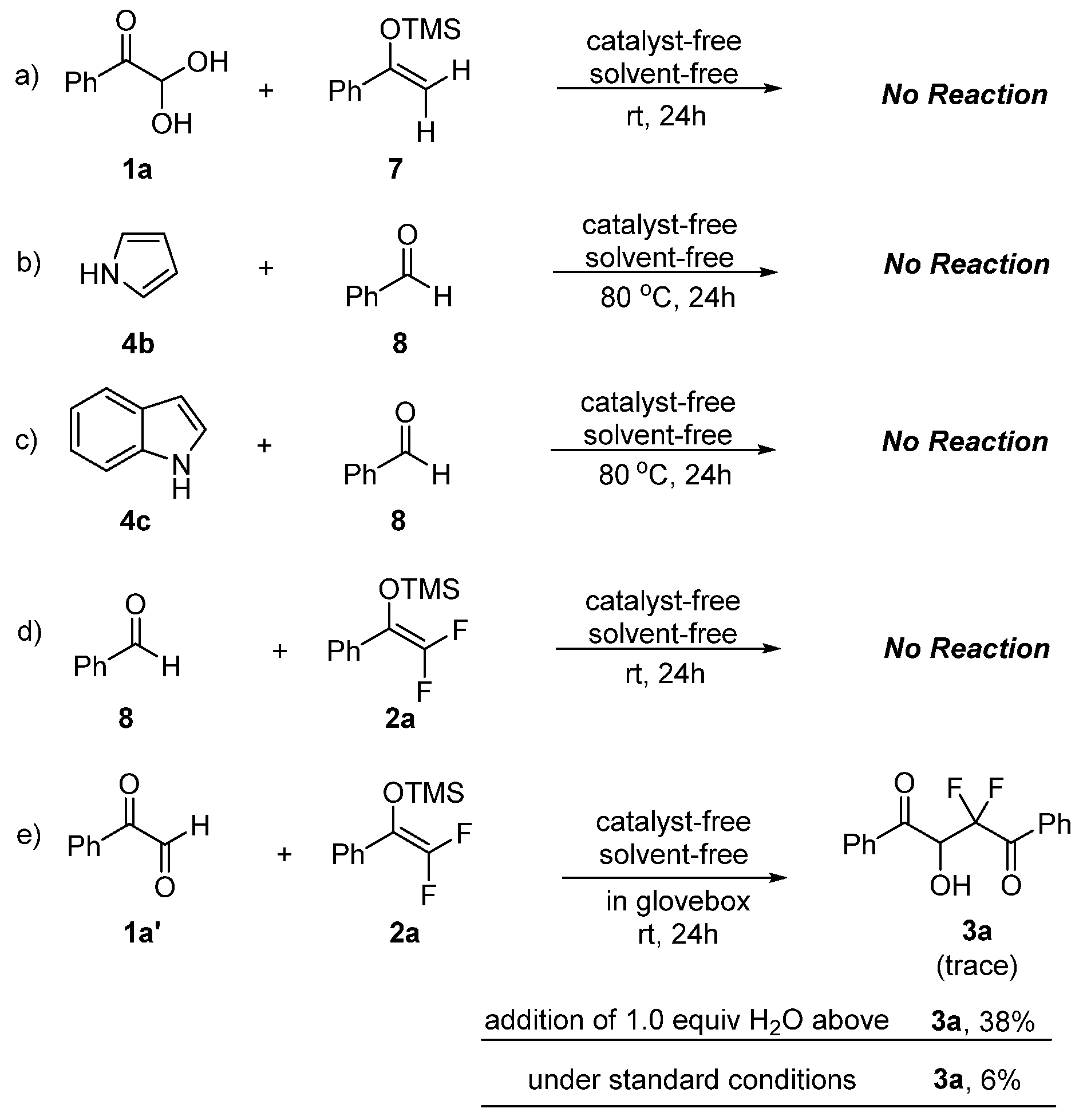
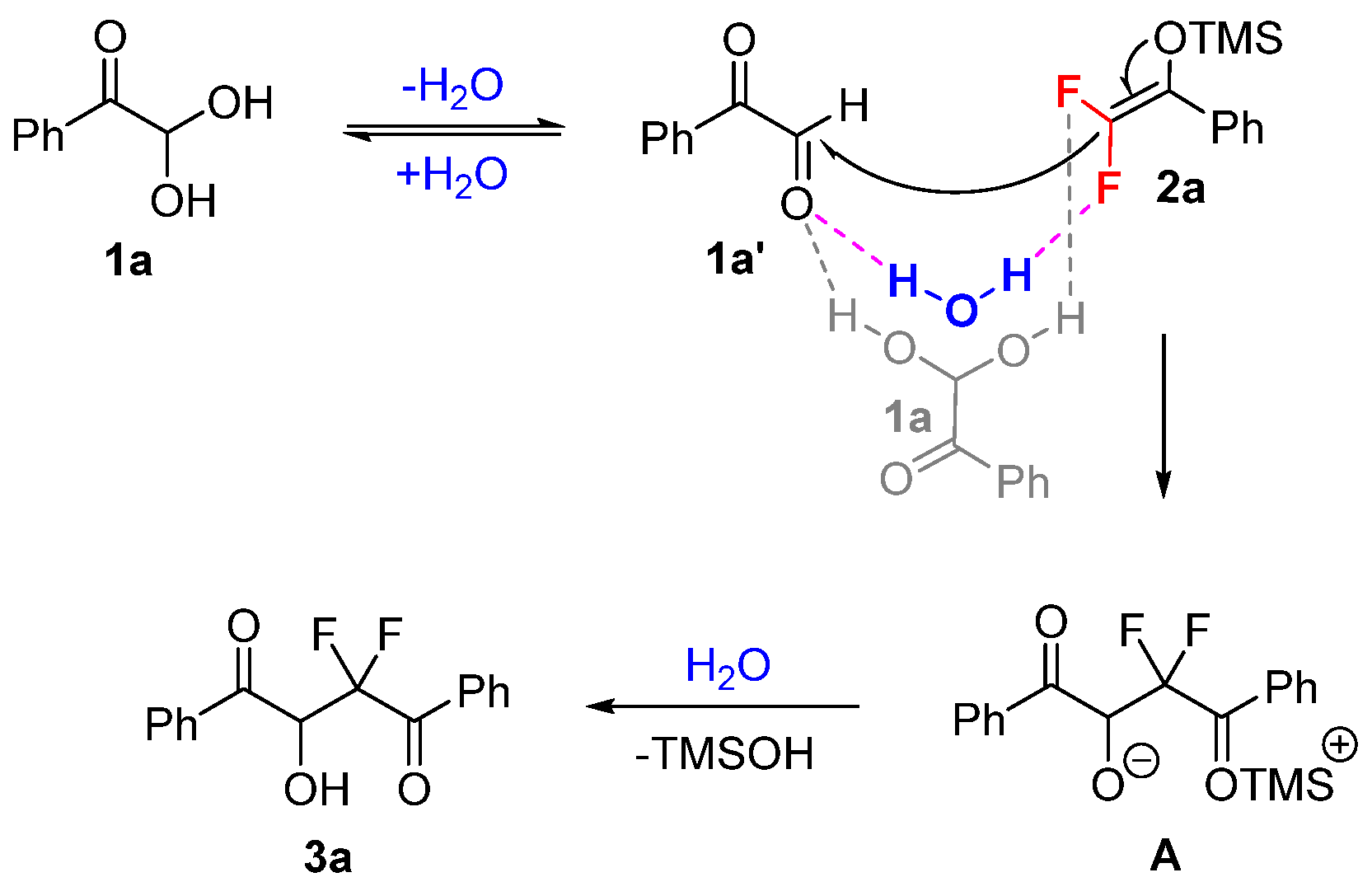
 | |||
| Entry | Solvent | Time (h) | Yield (%) b |
| 1 | − | 4 | 91 |
| 2 c | − | 4 | 89 |
| 3 d | − | 2 | 64 |
| 4 e | toluene | 36 | 9 |
| 5 e | DCM | 36 | 6 |
| 6 e | THF | 36 | trace |
| 7 e | MeOH | 36 | 23 |
| 8 e | EtOH | 36 | 16 |
| 9 e | H2O | 36 | 19 |
| 10 f | DCM | 36 | 42 |
| 11 g | DCM | 36 | 28 |
| 12 h | DCM | 36 | 13 |
Disclaimer/Publisher’s Note: The statements, opinions and data contained in all publications are solely those of the individual author(s) and contributor(s) and not of MDPI and/or the editor(s). MDPI and/or the editor(s) disclaim responsibility for any injury to people or property resulting from any ideas, methods, instructions or products referred to in the content. |
© 2024 by the authors. Licensee MDPI, Basel, Switzerland. This article is an open access article distributed under the terms and conditions of the Creative Commons Attribution (CC BY) license (https://creativecommons.org/licenses/by/4.0/).
Share and Cite
Li, L.; Li, J. Solvent- and Catalyst-Free Synthesis of gem-Difluorinated and Polyfluoroarylated Compounds with Nucleophilic or Electrophilic Fluorine-Containing Reaction Partners, Respectively. Molecules 2024, 29, 697. https://doi.org/10.3390/molecules29030697
Li L, Li J. Solvent- and Catalyst-Free Synthesis of gem-Difluorinated and Polyfluoroarylated Compounds with Nucleophilic or Electrophilic Fluorine-Containing Reaction Partners, Respectively. Molecules. 2024; 29(3):697. https://doi.org/10.3390/molecules29030697
Chicago/Turabian StyleLi, Lingheng, and Jinshan Li. 2024. "Solvent- and Catalyst-Free Synthesis of gem-Difluorinated and Polyfluoroarylated Compounds with Nucleophilic or Electrophilic Fluorine-Containing Reaction Partners, Respectively" Molecules 29, no. 3: 697. https://doi.org/10.3390/molecules29030697
APA StyleLi, L., & Li, J. (2024). Solvent- and Catalyst-Free Synthesis of gem-Difluorinated and Polyfluoroarylated Compounds with Nucleophilic or Electrophilic Fluorine-Containing Reaction Partners, Respectively. Molecules, 29(3), 697. https://doi.org/10.3390/molecules29030697






